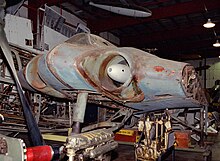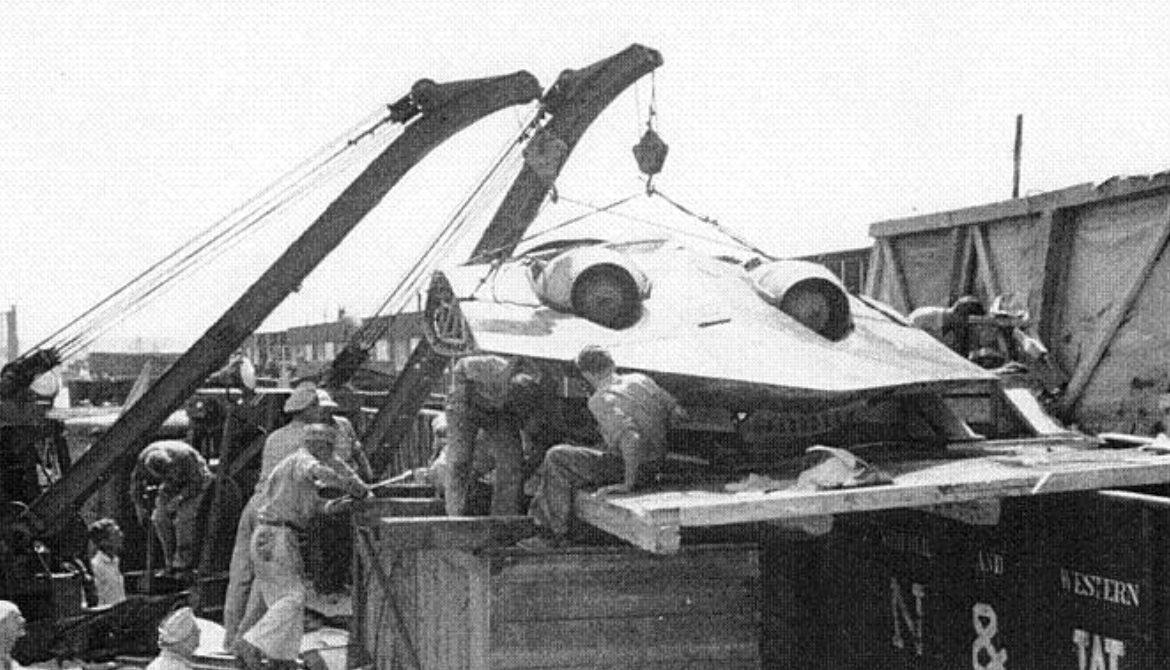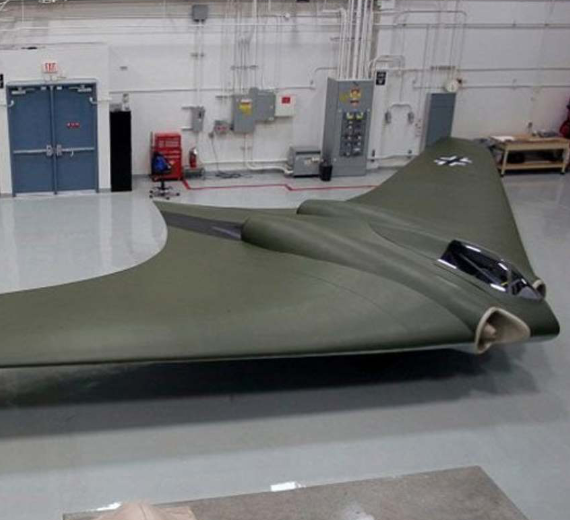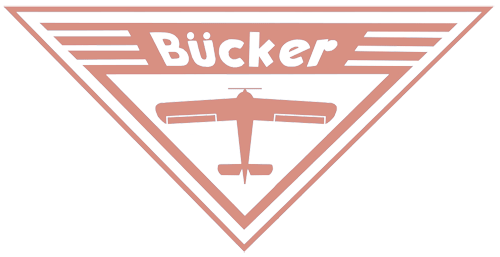.
History Gothaer Waggonfabrik
Horten H.IX, Ho 229

The Horten H.IX, RLM designation Ho 229 (or Gotha Go 229 for extensive re-design work done by Gotha to prepare the aircraft for mass production) was a German prototype fighter/bomber designed by Reimar and Walter Horten to be built by Gothaer Waggonfabrik. Developed at a late stage of the Second World War, it was the first flying wing to be powered by jet engines
The Ho 229 was designed in response to a call by Hermann Göring, the head of the Luftwaffe, in 1943 for light bombers capable of meeting the "3×1000" requirement; namely, to carry 1,000 kilograms (2,200 lb) of bombs a distance of 1,000 kilometres (620 mi) with a speed of 1,000 kilometres per hour (620 mph). Only jet propulsion could achieve the required speed, but such engines were relatively primitive and very fuel-hungry, necessitating considerable effort across the rest of the design to satisfy the range requirement. The flying wing configuration was favoured by the Horten brothers due to its high aerodynamic efficiency, as demonstrated by their Horten H.IV glider. In order to minimise drag, the Ho 229 was not fitted with extraneous flight control surfaces. Its ceiling was 15,000 metres (49,000 ft). The Ho 229 was the only design that even came close to the requirements, and the Horten brothers quickly received an order for three prototypes after the project garnered Göring's approval..
Variants


- H.IX V1
- First prototype, an unpowered glider, one built and flown (three-view drawing below).
- H.IX V2
- First powered prototype, one built and flown with twin Junkers Jumo 004B engines.
Gotha developments:
- Ho 229 V3
- Revised air intakes, engines moved forward to correct longitudinal imbalance. Its nearly completed airframe was captured in production, with two Junkers Jumo 004B jet engines installed in the airframe.
- Ho 229 V4
- Planned two-seat all-weather fighter, in construction at Friedrichroda, but not much more than the center-section's tubular framework completed.
- Ho 229 V5
- Planned two-seat all-weather fighter, in construction at Friedrichroda, but not much more than the center-section's tubular framework completed.
- Ho 229 V6
- Projected definitive single-seat fighter version with different cannon, one captured in production at Ilmenau by US troops.
Horten developments:
- H.IXb (also designated V6 and V7 by the Hortens)
- Projected two-seat trainer or night-fighter; not built.
- Ho 229 A-0
- Projected expedited production version based on Ho 229 V6; not built.
0
KmCeiling
0
KmCombat RANGE
0
Km/hAircraft Speed
0
Max Crew
Photo Gallery
Gothaer Waggonfabrik
Horten H.IX, Ho 229


Gothaer Waggonfabrik
GWF
Horten H.IX, Ho 229
General Info
-
-
- Crew: 1
- Length: 7.4 m (24 ft 3 in) chord at centre-line
-
-
- Ho 229A: 7.47 m (24.5 ft)
-
- Wingspan: 16.8 m (55 ft 1 in)
-
-
- Ho 229A: 16.76 m (55.0 ft)
-
- Height: 1.1 m (3 ft 7 in) cockpit height
-
-
- Ho 229A: 2.81 m (9 ft 3 in) overall height
-
- Wing area: 52.8 m2 (568 sq ft)
-
-
- Ho 229A: 50.2 m2 (540 sq ft)
-
-
Powerplant
-
-
- Empty weight: 4,844 kg
-
-
- Ho 229A: 4,600 kg
-
- Max takeoff weight: 6,876 kg
-
-
- Ho 229A: 8,100 kg (17,900 lb)
-
- Fuel capacity: 1,700 kg
- Powerplant: 2 × Junkers Jumo 004B turbojet engine, 8.83 kN (1,990 lbf) thrust each
-
Performance
- Maximum speed: 960 km/h (600 mph
-
-
-
Ho 229A: 950 km/h (590 mph; 510 kn) / M0.77 at sea level; 977 km/h (607 mph; 528 kn) / M0.92 at 12,000 m
Cruise speed: 900 km/h (560 mph,
-
Ho 229A: 950 km/h (590 mph; 510 kn) / M0.77 at sea level; 977 km/h (607 mph; 528 kn) / M0.92 at 12,000 m
-
- Never exceed speed: 1,000 km/h
- Take-off speed: 150 km/h
- Landing speed: 130 km/h
- Range: 1,900 km (1,200 mi, maximum
.
Links to Youtube & Others
During the early 1930s, the Horten brothers had become interested in the flying wing configuration as a method of improving the performance of gliders.
Gothaer Waggonfabrik
Horten H.IX, Ho 229
n 1983, Reimar Horten stated that he intended to mix charcoal dust in with the wood glue to absorb electromagnetic waves (radar),
Youtube Link
A jet-powered flying wing design such as the Horten Ho 229 has a smaller radar cross-section (RCS) than conventional contemporary twin-engine aircraft because the wings blended into the fuselage and there are no large propeller disks or vertical and horizontal tail surfaces to provide a typical identifiable radar signature











